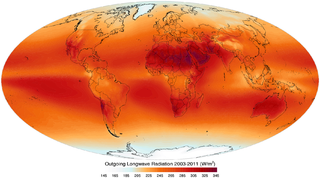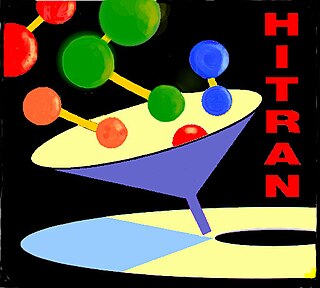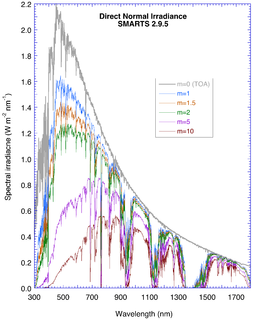
Transmittance of the surface of a material is its effectiveness in transmitting radiant energy. It is the fraction of incident electromagnetic power that is transmitted through a sample, in contrast to the transmission coefficient, which is the ratio of the transmitted to incident electric field.
Radiative transfer is the physical phenomenon of energy transfer in the form of electromagnetic radiation. The propagation of radiation through a medium is affected by absorption, emission, and scattering processes. The equation of radiative transfer describes these interactions mathematically. Equations of radiative transfer have application in a wide variety of subjects including optics, astrophysics, atmospheric science, and remote sensing. Analytic solutions to the radiative transfer equation (RTE) exist for simple cases but for more realistic media, with complex multiple scattering effects, numerical methods are required. The present article is largely focused on the condition of radiative equilibrium.
FUTBOLIN is a multi-level multiple scattering radiative transfer model for the calculation of line-by-line atmospheric emission/transmission spectra in planetary atmospheres. It has been developed by Javier Martín-Torres. It allows generating high-resolution synthetic spectra in the 0.3-1000 micrometre spectral range.

Outgoing Long-wave Radiation (OLR) is electromagnetic radiation of wavelengths between 3.0 and 100 μm emitted from Earth and its atmosphere out to space in the form of thermal radiation. It is also referred to as up-welling long-wave radiation and terrestrial long-wave flux, among others. The flux of energy transported by outgoing long-wave radiation is measured in W/m2. In the Earth's climate system, long-wave radiation involves processes of absorption, scattering, and emissions from atmospheric gases, aerosols, clouds and the surface.
An Atmospheric radiative transfer model, code, or simulator calculates radiative transfer of electromagnetic radiation through a planetary atmosphere, such as the Earth's.

HITRAN - The HITRAN molecular spectroscopic database is a compilation of spectroscopic parameters used to simulate and analyze the transmission and emission of light in gaseous media, with an emphasis on planetary atmospheres. An online tool for browsing, filtering, and plotting the data, called HITRANonline, is available at https://hitran.org/. The knowledge of spectroscopic parameters for transitions between energy levels in molecules is essential for interpreting and modeling the interaction of radiation (light) with different media.
Streamer is a radiative transfer code to calculate radiances (intensities) or irradiances in the atmosphere.
6SV1 is an advanced radiative transfer code designed to simulate the reflection of solar radiation by a coupled atmosphere-surface system for a wide range of atmospheric, spectral and geometrical conditions. It belongs to the group of procedures called Atmospheric correction for the process of removing the effects of the atmosphere on the reflectance values of images taken by satellite or airborne sensors. The code operates on the basis of an SOS method and accounts for the polarization of radiation in the atmosphere through the calculation of the Q and U components of the Stokes vector. It is a basic code for the calculation of look-up tables in the MODIS atmospheric correction algorithm.
In spectroscopy, spectral flux density is the quantity that describes the rate at which energy is transferred by electromagnetic radiation through a real or virtual surface, per unit surface area and per unit wavelength. It is a radiometric rather than a photometric measure. In SI units it is measured in W m−3, although it can be more practical to use W m−2 nm−1 or W m−2 μm−1, W·m−2·Hz−1, Jansky or solar flux units. The terms irradiance, radiant exitance, radiant emittance, and radiosity are closely related to spectral flux density.
4A/OP or, Automatized Atmospheric Absorption Atlas, is an operational fast and accurate radiative transfer model for the infrared.
LBLRTM - The Line-By-Line Radiative Transfer Model is an accurate, efficient and highly flexible model for calculating spectral transmittance and radiance.
The Rapid Radiative Transfer Model (RRTM) is a validated, correlated k-distribution band model for the calculation of solar and thermal-infrared atmospheric radiative fluxes and heating rates. The Rapid Radiative Transfer Model for GCMs (RRTM-G) is an accelerated version of RRTM that provides improved efficiency with minimal loss of accuracy for application to general circulation models. The latter divides the solar spectrum into 14 bands within which a total of 112 pseudo-monochromatic calculations are performed, and in the thermal infrared 16 bands are used within which 140 pseudo-monochromatic calculations are performed. RRTM-G is used in a number of general circulation models worldwide, such as that of the European Centre for Medium-Range Weather Forecasts.
Radiative equilibrium is one of the several requirements for thermodynamic equilibrium, but it can occur in the absence of thermodynamic equilibrium. There are various types of radiative equilibrium, which is itself a kind of dynamic equilibrium.
RTTOV - the fast radiative transfer model for calculations of radiances for satellite infrared or microwave nadir scanning radiometers.
The Community Radiative Transfer Model (CRTM) is a fast radiative transfer model for calculations of radiances for satellite infrared or microwave radiometers.

Specific (radiative) intensity is a quantity used in physics that describes electromagnetic radiation. It is a term used in much of the older scientific literature. The present-day SI term is spectral radiance, which can be expressed in base SI units as W m−2 sr−1 Hz−1.

The Simple Model of the Atmospheric Radiative Transfer of Sunshine, or SMARTS for short, is a computer program designed to evaluate the surface solar irradiance components in the shortwave spectrum under cloudless conditions. The program, written in FORTRAN, relies on simplifications of the equation of radiative transfer to allow extremely fast calculations of the surface irradiance. The irradiance components can be incident on a horizontal, a fixed-tilt or a 2-axis tracking surface. SMARTS can be used for example to evaluate the energy production of solar panels under variable atmospheric conditions. Many other applications are possible.
COART - COART is established on the Coupled DIScrete Ordinate Radiative Transfer code, developed from DISORT. It is designed to simulate radiance and irradiance (flux) at any levels in the atmosphere and ocean consistently.

ARTS is a widely used atmospheric radiative transfer simulator for infrared, microwave, and sub-millimeter wavelengths. While the model is developed by a community, core development is done by the University of Hamburg and Chalmers University, with previous participation from Luleå University of Technology and University of Bremen.
MOSART is an atmospheric radiative transfer algorithm developed by the US Department of Defense. Development has halted as funding for the project has ended. In order to continue development, Computational Physics, Inc. (CPI) has created AETHER, built from MOSART.





